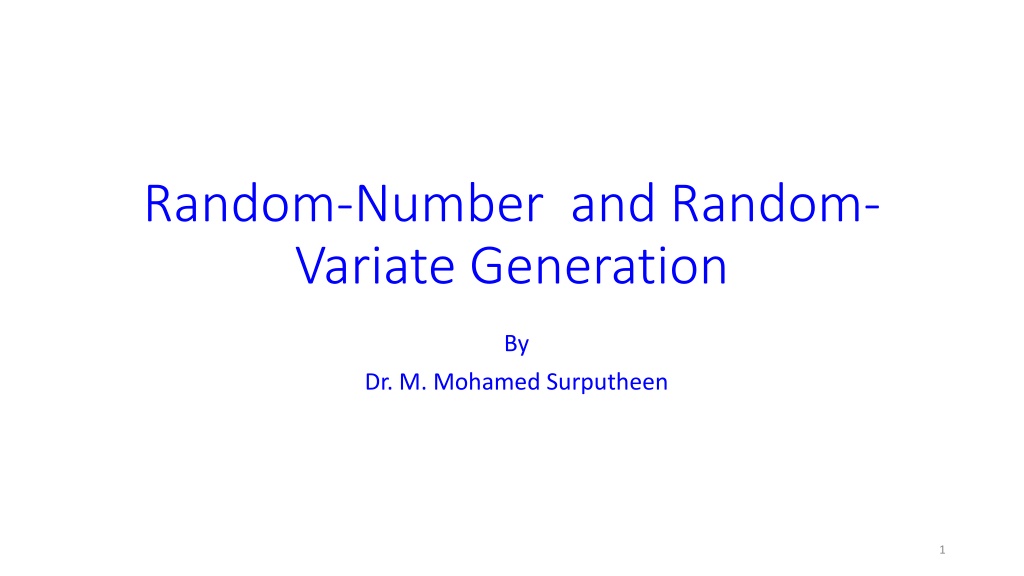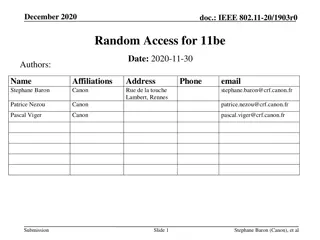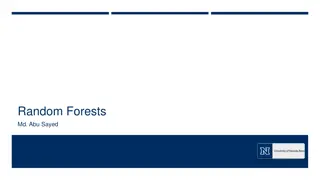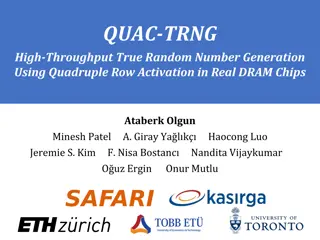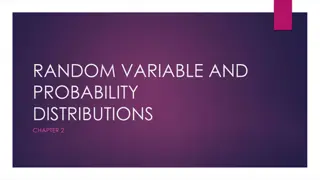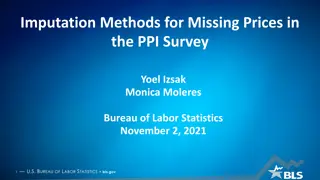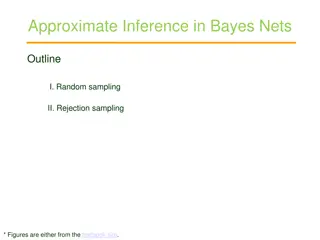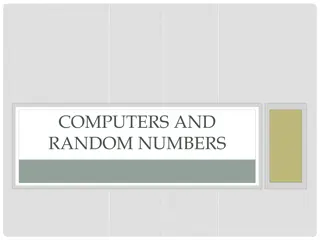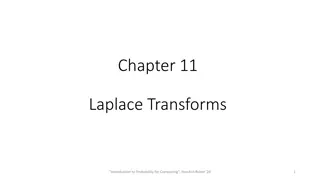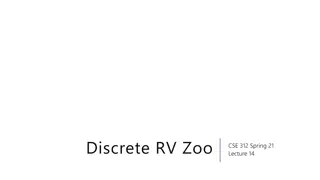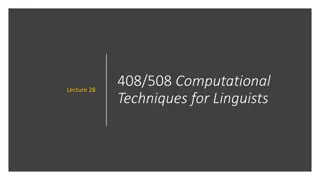Random Number and Variate Generation Overview
Random numbers play a crucial role in modern computing, aiding in cryptography, simulation, and system testing. This overview delves into the properties of random numbers, the generation of pseudo-random numbers, techniques for generating them, and tests for their validity. It explores the significance of random variate generation and historical methods like dice throwing, coin flipping, and card shuffling. Additionally, it emphasizes the importance of uniformity and independence in generating random numbers.
Download Presentation

Please find below an Image/Link to download the presentation.
The content on the website is provided AS IS for your information and personal use only. It may not be sold, licensed, or shared on other websites without obtaining consent from the author.If you encounter any issues during the download, it is possible that the publisher has removed the file from their server.
You are allowed to download the files provided on this website for personal or commercial use, subject to the condition that they are used lawfully. All files are the property of their respective owners.
The content on the website is provided AS IS for your information and personal use only. It may not be sold, licensed, or shared on other websites without obtaining consent from the author.
E N D
Presentation Transcript
Random-Number and Random- Variate Generation By Dr. M. Mohamed Surputheen 1
Overview Properties of Random Numbers Generation of Pseudo Random Numbers Techniques for Generating Random Numbers Tests for random numbers Random-Variate Generation 2
Random Number Generation A random number is a number that cannot be predicted by an observer before it is generated. Pseudo-random number is a sequence of numbers that appears to be random that is generated using an initial value. Random numbers are an important part of the modern world of computing. Cryptography, simulation, and system testing all rely on random number generation
Random numbers are necessary basic ingredient in the simulation of almost all discrete system. Most computer languages have a subroutine or function that will generate a random number. Random numbers play a key role in discrete event simulation. Simulation languages generate random numbers that are used to produce random arrival/service times and event times and other random variables in general. A random number generator (RNG) is a computational or physical device designed to generate a sequence of numbers that appear random.
Historical methods of generating random numbers include: 1. Dice throwing. 2. Coin Flipping. 3. Shuffling of playing cards. Alternatively results can be collected and passed out as random number tables. In modern days, With the advent of computers there are several techniques to Quickly generate random numbers . A random number is a number uniformly distributed between 0 and 1.
1.Properties of Random Numbers A sequence of random numbers R1, R2, , must have two important statistical properties: 1. Uniformity 2. Independence. Random Number, Ri, must be independently drawn from a uniform distribution with pdf: pdf for random numbers , 1 0 1 x = ( ) f x otherwise , 0 1 2 1 x 1 = = = ( ) E R xdx 2 2 0 0 1 2 3 1 1 1 1 x ( ) R 1 = 2 = = = 2 ( ) V R x dx E 3 2 3 4 12 0 0 6
Properties of Random Numbers (cont.) Uniformity: If the interval [0,1] is divided into n classes, or subintervals of equal length, the expected number of observations in each interval is N/n, where N is the total number of observations In a uniform distribution, any number within the specified range [ for eg. 0 to 1] has equal probability of occurring Independence: The probability of observing a value in a particular interval is independent of the previous value drawn (ie) the current value of a random variable has no relation with the previous values. 7
2.Generation of Pseudo-Random Numbers The word Pseudo is used, because generating numbers using a known method removes the potential for true randomness. Since the sequence of numbers is deterministic they are referred to as "pseudo-random". Goal: To produce a sequence of numbers between [0, 1] that simulates, or replicates, the ideal properties of random numbers (RN). 8
Generation of Pseudo-Random Numbers(cntd) Problems that occur in generation of pseudo-random numbers (PRN) Generated numbers might not be uniformly distributed Generated numbers might be discrete-valued instead of continuous-valued Mean of the generated numbers might be too low or too high Variance of the generated numbers might be too low or too high There may be dependence Examples: a) Autocorrelation between numbers. b) Numbers successively higher or lower than adjacent numbers. c)Several numbers above the mean followed by several numbers below the mean 9
Generation of Pseudo-Random Numbers(cont.) Important considerations in RN routines: The routine should be fast. Individual computations are inexpensive, but a simulation may require many millions of random numbers Portable to different computers ideally to different programming languages. This ensures the program produces same results Have sufficiently long cycle. The cycle length, or period represents the length of random number sequence before previous numbers begin to repeat in an earlier order. Replicable. Given the starting point, it should be possible to generate the same set of random numbers, completely independent of the system that is being simulated Closely approximate the ideal statistical properties of uniformity and independence. 10
3. Techniques for Generating Random Numbers Linear Congruential method To produce a sequence of integers, X1, X2, between 0 and m-1 by following a recursive relationship: The initial value X0is called the seed The selection of the values for a, c, m, and X0 drastically affects the statistical properties and the cycle length. If c 0 then it is called mixed congruential method When c=0 it is called multiplicative congruential method 11
Linear Congruential Method The random integers are being generated in the range [0,m-1], and to convert the integers to random numbers: X = 2 , 1 = , ,... i R i i m 12
Linear Congruential Method (cont.) EXAMPLE: Use X0 = 27, a = 17, c = 43, and m = 100. The Xi and Ri values are: X1 = (17*27+43) mod 100 = 502 mod 100 = 2, R1= 2/100 = 0.02 X2 = (17*2+43) mod 100 = 77 mod 100 =77, R2= 77/100 = 0.77 X3 = (17*77+43) mod 100 = 1352 mod 100 = 52 R3= 52/100 = 0.52 Notice that the numbers generated assume values only from the set I = {0,1/m,2/m, .., (m-1)/m} because each Xi is an integer in the set {0,1,2, .,m-1} Thus each Ri is discrete on i, instead of continuous on interval [0,1] 13
Linear Congruential Method(cont.) Characteristics of a Good Generator The primary importance of LCM is uniformity and independence. The secondary importance is maximum density and maximum period within the sequence. Maximum Density Maximum density means that the values assumed by Ri, i = 1,2, , leave no large gaps on [0,1] Solution: a very large integer for modulus m (e.g., m= 231-1, 248) Maximum Period To avoid cycling (i.e. recurrence of the same sequence of generated numbers) the generator should have the largest possible period. This can be achieved by proper choice of a, c, m, and Xo. 14
Linear Congruential Method(cont.) Maximum Period or Cycle Length: i) For Mixed Linear Congruential Generators (c 0) For m a power of 2, say m=2b, and c 0, the longest possible period is P=m=2b, which is achieved when c is relatively prime to m (greatest common divisor of c and m is 1) and a=1+4k, where k is an integer ii) For Multiplicative Linear Congruential Generators (c=0) For m a power of 2, say m=2b, and c=0, the longest possible period is P=m/4=2b-2, which is achieved if the seed X0is odd and if the multiplier a is given by a=3+8k or a=5+8k for some k=0,1, . For m a prime number and c=0, the longest possible period is P=m-1, which is achieved whenever the multiplier a has the property that the smallest integer k such that ak-1 is divisible by m is k=m-1 15
Linear Congruential Method (cont.) Example: Using the multiplicative congruential method, find the period of the generator for a = 13, m = 26, and X0 = 1, 2, 3, and 4. The solution is given in next slide. When the seed is 1 and 3, the sequence has period 16. However, a period of length eight is achieved when the seed is 2 and a period of length four occurs when the seed is 4.
Linear Congruential Method(cont.) Speed and efficiency in using the generator on a digital computer is also a factor Speed and efficiency are aided by using a modulus m either a power of 2 (=2b)or close to it After the ordinary arithmetic yields a value of aXi+c, Xi+1 can be obtained by dropping the leftmost binary digits and then using only the b rightmost digits 18
Linear Congruential Method (cont.) Example:c=0; a=75=16807; m=231-1=2,147,483,647 (prime number) Period P=m-1 (well over 2 billion) Assume X0=123,457 Xi+1 = aXi mod m X1=75(123457)mod(231-1)=2,074,941,799 R1=X1/231=0.9662 X2=75(2,074,941,799) mod(231-1)=559,872,160 R2=X2/231=0.2607 X3=75(559,872,160) mod(231-1)=1,645,535,613 R3=X3/231=0.7662 . Note that the routine divides by m+1 instead of m. Effect is negligible for such large values of m. 19
4. Tests for Random Numbers Desirable properties of random numbers: Uniformity and Independence. Number of tests can be performed to check these properties been achieved or not. Tests of whether the distribution of the set of random number is uniform are frequently called frequency tests. Tests of whether the generated numbers are independent of one another are called independence tests Tests for Uniformity Frequency Test: Uses the Kolmogorov-Smirnov or the Chi-square test to compare the distribution of the set of numbers generated to a uniform distribution Tests for Independence Runs test: Tests the runs up and down or the runs above and below the mean by comparing the actual values to expected values. The statistic for comparison is the chi-square. Autocorrelation test: Tests the correlation between numbers and compares the sample correlation to the expected correlation of zero. 20
Tests for Random Numbers (cont.) Two categories: Testing for uniformity. The hypotheses are: H0: Ri ~ U[0,1] (ie) numbers are uniformly generated H1: Ri U[0,1] (ie) numbers are not uniformly distributed Failure to reject the null hypothesis, H0, means that evidence of non- uniformity has not been detected. Testing for independence. The hypotheses are: H0: Ri ~ independently distributed H1: Ri independently distributed Failure to reject the null hypothesis, H0, means that evidence of dependence has not been detected. 21
Tests for Random Numbers(cont.) For each test, a Level of significance must be stated. The level , is the probability of rejecting the null hypothesis H0 when the null hypothesis is true: = P(reject H0|H0 is true) The decision maker sets the value of for any test Frequently a is set to 0.01 or 0.05 22
Tests for Random Numbers(cont.) When to use these tests? If a well-known simulation languages or random-number generators is used, it is probably unnecessary to test If the generator is not explicitly known or documented, e.g., spreadsheet programs, symbolic/numerical calculators, tests should be applied to many sample numbers. Types of tests: Theoretical tests: evaluate the choices of m, a, and c without actually generating any numbers Empirical tests or Statistical test: applied to actual sequences of numbers produced. Here we emphasize empirical tests that are applied to actual sequences of numbers produced by a generator. 23
Test of uniformity Frequency Tests Two different methods: 1. Kolmogorov-Smirnov test 2. Chi-square test Both these tests measure the degree of agreement between the distribution of a sample of generated random numbers and the theoretical uniform distribution Both tests are based on null hypothesis of no significant difference between the sample distribution and the theoretical distribution 24
Frequency Tests Kolmogorov-Smirnov Test This test compares the continuous cdf, F(x) of the uniform distribution to the empirical cdf, SN(x), of the sample of N random numbers. We know: If the sample from the RN generator is R1, R2, , RN, then the empirical cdf, SN(x) is: R R R x S N = ) ( = ( ) , x 0 1 F x x number of , ,..., which are x 1 2 n N The cdf of an empirical distribution is a step function with jumps at each observed value. The largest absolute deviation between F(x) and SN(x) is determined and is compared with the critical value, which is available in a table. D = max| F(x) - SN(x)| The distribution of D is known and tabulated (A.8) as function of N 25
Steps: 1. Rank the data from the smallest to largest 2. Compute D+ = max { i/N Ri } D- = max { Ri (i-1)/N } 3. Compute D = max (D+ , D- ) 4. Locate the critical value of D for the significant level a and the given sample N in table A.8 5. If D > D , then, the null hypothesis H0 is rejected. 6. If D <= D , then, there is no difference b/w the true distribution of random numbers generated and the uniform distribution. Hence the null hypothesis is accepted.(i.e, the given random numbers are uniformly distributed. 26
Kolmogorov-Smirnov Test Example. Step 3: D+ = max{i/N -R(i)} = 0.26 D- = max{R(i) - (i-1)/N} = 0.21 D = max {D+,D-} = 0.26 Step 4: For a = 0.05, Value from the table = 0.565 D <= Da Hypothesis is not rejected (ie. The given random numbers are uniformly distributed. 27
Table A.8 Table A.8 Kolmogorov Kolmogorov- -Smirnov critical values Smirnov critical values
The Chi-square Test The chi-square test uses the sample statistic: ( ) 2 E n O E = i = 2 0 i i 1 i Where: Oi = the number of observations in the i-th class Ei = the expected number in the i-th class n = the number of classes.
The Chi-square Test Step 1: Divide [0,1) into intervals that represent each discrete value. Step 2: Count how many generated values are in each interval Step 3:Calculate: ( ) 2 E n O E = i = 2 0 i i 1 i
The Chi-square Test Step 4: For significant level , utilize the table (Percentage points of the chi square distribution with degrees of freedom) to determine ,n-1. Step 5: If 02 2 ,n-1 Accept the hypothesis: If 02> 2 ,n-1 Reject the hypothesis:
Chi-Square Test (cont.) Example : Use Chi-square test for the data shown below with =0.05. The test uses n=10intervals of equal length, namely [0,0.1),[0.1,0.2), ., [0.9,1.0) 33
Chi-Square Test(cont.) The value of 02=3.4; The critical value from table A.6 is 0.05,92=16.9. Therefore the null hypothesis is not rejected 34
Table A.6 Percentage points of the Chi Table A.6 Percentage points of the Chi- -Square Distribution with degrees of Freedom of Freedom Square Distribution with degrees
Notes on Uniformity tests Both the Kolmogorov-Smirnov test and the chi-square test are acceptable for testing the uniformity of sample data provided that the sample size is large. The KS test can be applied to small sample sizes, whereas the chi- square test is valid only for large samples, e.g.: N 50. The KS test is more powerful and is recommended
Tests for independence Sometimes the generators pass the Kolmogorov-Smirnov and chi-square tests but the numbers generated are not independent need independence tests Runs Tests : The runs test examines the arrangement of numbers in a sequence to test the hypothesis of independence. Run : A run is defined as succession of similar events preceded and followed by a different event. The length of the Run is the number of events that occur in a Run. Example: coin flipping: H T T H H T T T H T Six runs: length 1, 2, 2, 3, 1, 1
Runs up and Runs Down Two concerns in a Runs Test: 1. The number of Runs 2. The length of the Runs. An up run is a sequence of numbers which is succeeded by a larger number. A down run is a sequence of numbers each of which is succeeded by a smaller number. If a sequence of numbers have too few runs, it is unlikely a real random sequence. E.g. 0.08, 0.18, 0.23, 0.36, 0.42, 0.55, 0.63, 0.72, 0.89, 0.91, the sequence has one run, an up run. It is not likely a random sequence. If a sequence of numbers have too many runs, it is unlikely a real random sequence. E.g. 0.08, 0.93, 0.15, 0.96, 0.26, 0.84, 0.28, 0.79, 0.36, 0.57. It has nine runs, five up and four down. It is not likely a random sequence
Runs up and Runs Down(cont.) If N is the number of numbers in a sequence, the maximum number of runs is N-1, and the minimum number of runs is one. If a is the total number of runs in a sequence, the mean and variance of a is given by
Runs up and Runs Down(cont.) a = (2N - 1) / 3 = (16N - 29) / 90 For N > 20, the distribution of a approximated by a normal distribution, N( a , ). This approximation can be used to test the independence of numbers from a generator. Z0= (a - a) / a 2 a 2 a
Runs up and Runs Down(cont.) Substituting for aand a ==> Za = {a - [(2N-1)/3]} / { (16N-29)/90}, where Z ~ N(0,1) Acceptance region for hypothesis of independence -Z Z0 Z (ie) if |z| <1.96 then H0 accepted at 5% level of significance. if |z| <2.58 then H0 accepted at 1% level of significance. / 2 / 2 -Z / 2 Z / 2
Runs up and Runs Down(cont.) Example: Based on runs up and runs down, determine whether the following sequence of 40 numbers is such that the hypothesis of independence can be rejected where = 0.05. 0.41 0.68 0.89 0.94 0.74 0.91 0.55 0.62 0.36 0.27 0.19 0.72 0.75 0.08 0.54 0.02 0.01 0.36 0.16 0.28 0.18 0.01 0.95 0.69 0.18 0.47 0.23 0.32 0.82 0.53 0.31 0.42 0.73 0.04 0.83 0.45 0.13 0.57 0.63 0.29
Runs up and Runs Down(cont.) The sequence of runs up and down is as follows: + + + + + + + + + + + + + + + + + + + There are 26 runs in this sequence. With N=40 and a=26, a = {2(40) - 1} / 3 = 26.33 = {16(40) - 29} / 90 = 6.79 Then, Z0 = (26 - 26.33) / ( ) = Now, the critical value is Z0.025 = 1.96, so the independence of the numbers cannot be rejected on the basis of this test. and 2 a
Runs above and below the mean The "runs above and below the mean" test is similar to runs up and down, except the runs are based on the difference of the random numbers from the mean. A positive run is a sequence of numbers above the mean, while a negative run is the opposite. Again we use the number of random numbers and the number of total runs to calculate the mean and standard deviation. If there are too many random numbers in a row over or under the mean, we know the numbers are probably not too random and we can reject the hypothesis of independence.
Runs above and below the mean(cont.) Variables: N = number of random numbers n1 = number of runs above the mean n2 = number of runs below the mean b = total number of runs Formula: Mean = Variance = For either n1or n2 greater than 20, b is approximately normally distributed
Runs above and below the mean(cont.) Example: Determine whether there is an excessive number of runs above or below the mean for the sequence of numbers given below: 0.41 0.68 0.89 0.94 0.74 0.91 0.55 0.62 0.36 0.27 0.19 0.72 0.75 0.08 0.54 0.02 0.01 0.36 0.16 0.28 0.18 0.01 0.95 0.69 0.18 0.47 0.23 0.32 0.82 0.53 0.31 0.42 0.73 0.04 0.83 0.45 0.13 0.57 0.63 0.29 The value is lower than the mean -. The value is higher than the mean +. - + + + + + + + - - - + + - + - - - - - - + + + + + + + - - - + + - + - - - - - - + + - - - - + + - - + - + - - + + - - - + + - - - - + + - - + - + - - + + -
Test for Auto-correlation The tests for auto-correlation are concerned with the dependence between numbers in a sequence. Example: 0.12 0.01 0.23 0.28 0.89 0.31 0.64 0.28 0.83 0.93 0.99 0.15 0.33 0.35 0.91 0.41 0.60 0.27 0.75 0.88 Examination of the 5th, 10th, 15th, ,etc. indicates a large number in that position. 0.68 0.49 0.05 0.43 0.95 0.58 0.19 0.36 0.69 0.87
